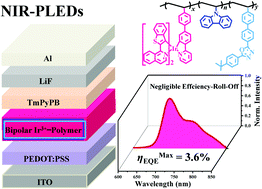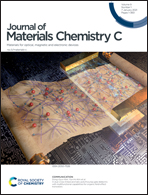High-performance near-infrared (NIR) polymer light-emitting diodes (PLEDs) based on bipolar Ir(iii)-complex-grafted polymers†
Abstract
Despite the cost-effective and large-area scalable advantages of NIR-PLEDs based on iridium(III)-complex-doped polymers, the intrinsic phase-separation issue leading to inferior device performance is difficult to address. In this study, taking the vinyl-functionalized [Ir(iqbt)2(vb-ppy)] (Hqibt = 1-(benzo[b]-thiophen-2-yl)-isoquinoline; vb-Hppy = 2-(4′-vinylbiphenyl-4-yl)pyridine) as the polymerized complex monomer, two series of Ir(III)-complex-grafted polymers Poly(NVK-co-[Ir(iqbt)2(vb-ppy)]) and Poly((vinyl-PBD)-co-NVK-co-[Ir(iqbt)2(vb-ppy)]) (NVK = N-vinyl-carbazole; vinyl-PBD = 2-(4-(tert-butyl)phenyl)-5-(4′-vinyl-[1,1′-biphenyl]-4-yl)-2,5-dihydro-1,3,4-oxadiazole) are obtained, respectively. Moreover, by using the bipolar Ir(III)-complex-grafted polymer further doped or grafted with an electron-transport unit as the emitting layer (EML), reliable NIR-PLEDs are realized. In particular based on the concurrent covalent-linkages of both the Ir(III)-complex and the vinyl-PBD towards the carrier-balanced NIR-PLED-III, the achievement of an almost negligible (<5%) efficiency roll-off does not sacrifice the attractive efficiency (ηmaxEQE = 3.6%). This finding makes bipolar Ir(III)-complex-grafted polymers a good platform to achieve high-performance NIR-PLEDs.



 Please wait while we load your content...
Please wait while we load your content...